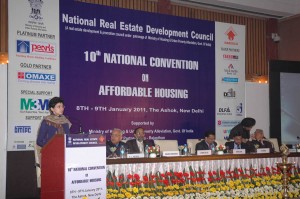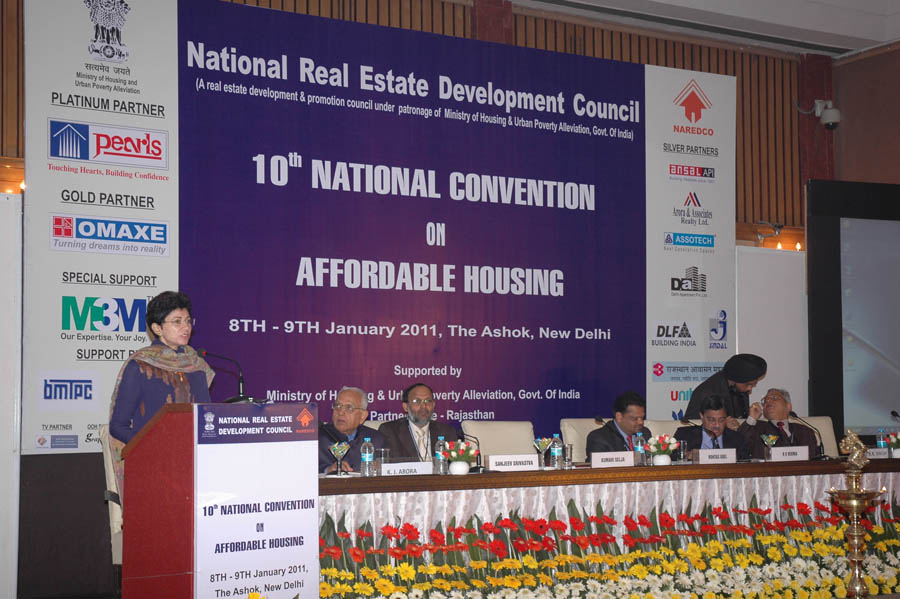By: Jaswinder Singh
 Kumari Selja, Union Minister of Housing and Urban Poverty Alleviation & Minister of Tourism, has categorically blamed the banks for not facilitating the affordable housing. Inaugurating the 10th National Convention of National Real Estate Development Council (NAREDCO) at New Delhi the minister said the housing finance sector has witnessed a boom in the recent past due to favorable government policies. Despite this, the affordable housing remained a “distant dream” for the poor because of banks’ reluctance to give credit to this section of society for various reasons.
Kumari Selja, Union Minister of Housing and Urban Poverty Alleviation & Minister of Tourism, has categorically blamed the banks for not facilitating the affordable housing. Inaugurating the 10th National Convention of National Real Estate Development Council (NAREDCO) at New Delhi the minister said the housing finance sector has witnessed a boom in the recent past due to favorable government policies. Despite this, the affordable housing remained a “distant dream” for the poor because of banks’ reluctance to give credit to this section of society for various reasons.
“A boom in housing finance has been witnessed due to supportive government policies and economic growth. Despite this boom, affordable housing remains a distant dream for the Economically Weaker Sections (EWS) and the Low Income Groups (LIG) of our society. Housing finance companies (HFCs) and banks hesitate to serve the low-income market for a variety of reasons such as inability to assess credit worthiness, uncertain cash flows and lower profits,” Kumari Selja said.
“To make a dent on the mega deficits in housing sector, involvement of scheduled banks, housing finance institutions and refinance organizations are essential, otherwise the quantum of funding would remain negligible,” she added. The minister also said that the government was working on developing a mechanism to allay the fears of banks/ HFCs in extending long term home loans to the poor.
“My ministry is in the process of innovating and recommending appropriate risk mitigating instruments to allay the fears of banks/HFCs in extending long term home loans to the poor. It is expected that with a hedge fund to cover risk in title instruments, more financial institutions would come forward. This would foster the goal of inclusive growth of the downtrodden sections of the society,” Kumari Selja said.
As per the report of Technical Group constituted by the Ministry of Housing and Urban Poverty Alleviation, the total urban housing shortage including the backlog and additional requirement would be 26.53 million dwelling units by the end of the 11th Five Year Plan period. 99% of this shortfall would be for economically weaker section and the low-income group segment, which contributes to squatting and slum formation.
“To meet this huge housing shortage, an investment of more than Rs. 6 lakh crore is estimated for construction of houses and related infrastructure, which will require significant contribution from central government, state governments and private stakeholders,” the minister suggested.
Kumari Selja also emphasized on the need of developing greener and environment friendly buildings for sustainable development. “There is a need to adopt appropriate, cost-effective building materials and technologies for affordable, strong, durable, functional and aesthetically pleasing houses. Technologies, which are environment friendly, ecologically appropriate and energy saving should be increasingly adopted for the purpose. It is important to focus on Green Building Technologies for sustainable development, she said.”
Speaking on the occasion Mr. Rohtas Goel, President, NAREDCO, said, “Demand for housing in India is huge. At a rough estimate, approximately 30 million houses are short in urban areas. Approximately 93 million people are living in slums. With economy growing at 8 -9 percent, more migrations are expected in future. The forecast is that urbanization level in India will grow to 40% by 2030 and 50% by 2040, from 28% at present. This is going to throw a huge potential as also a challenge for the housing industry.”





